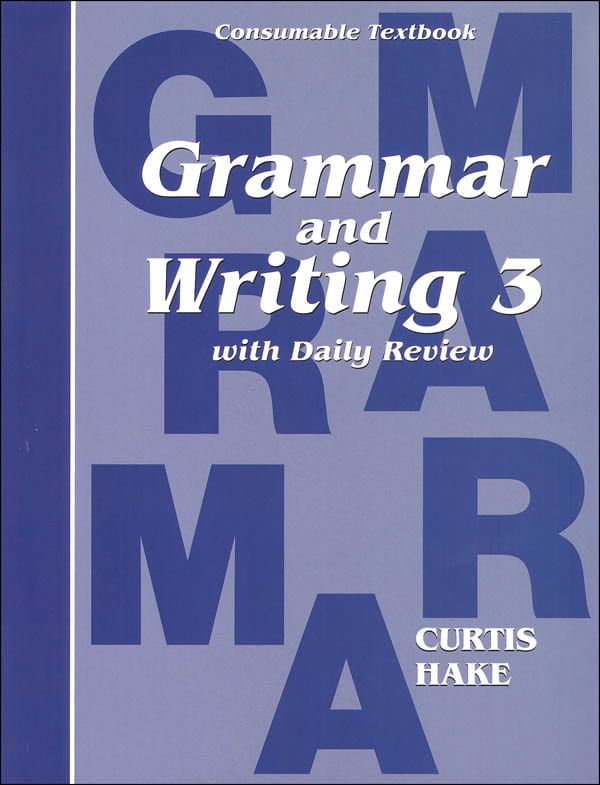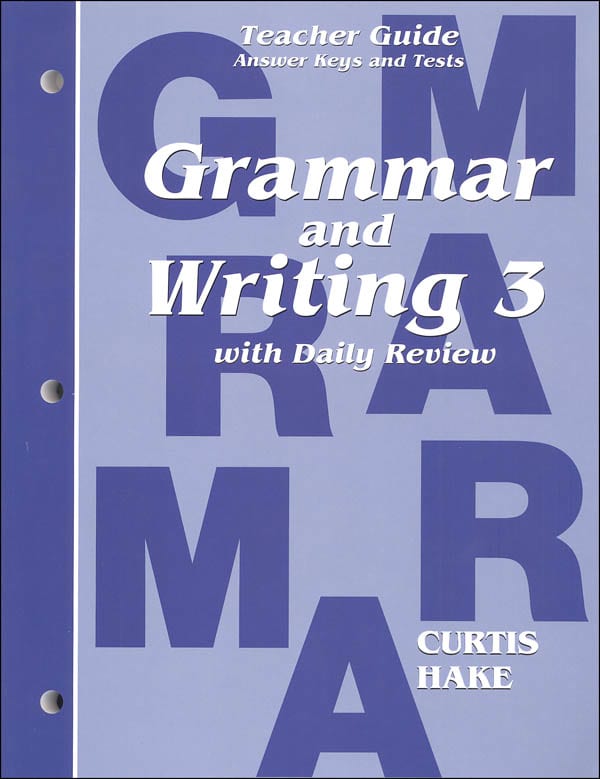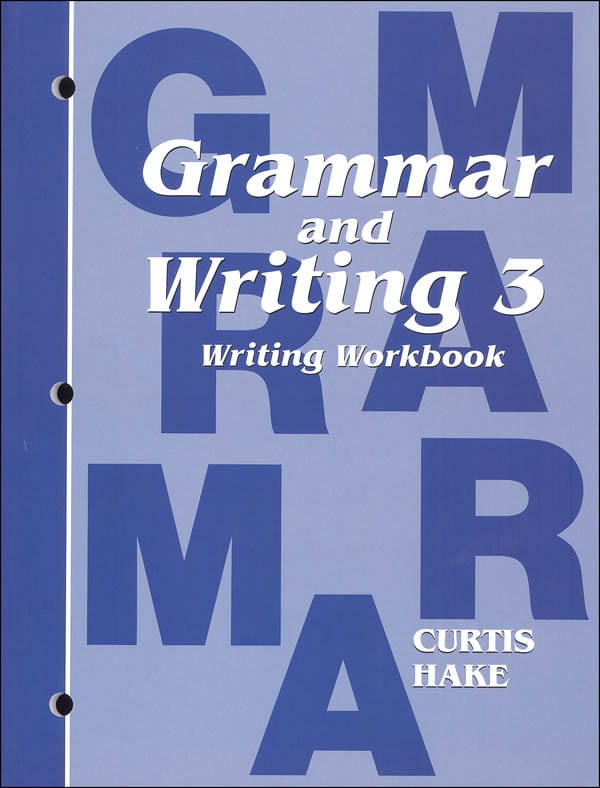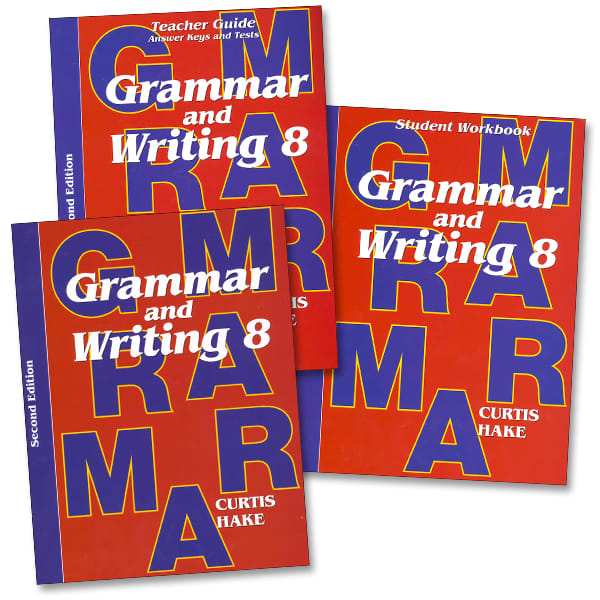The Saxon Grammar and Writing (SGW) program consists of courses for grades three through eight. In all of these courses, new concepts are taught in small increments, building upon prior concepts in a spiral fashion that helps students retain what they have learned. The program reviews and repeats through each level, so it is possible for a student to begin at any level.
This is a fairly comprehensive English program covering grammar, writing, spelling, punctuation, and vocabulary. Literature and reading are the only areas missing. Grammar instruction is very challenging and includes sentence diagramming.
The homeschool versions of each course have three components: a textbook, a writing workbook, and a teacher guide. All three books have softcovers and are printed in black and white. (School versions of these courses have a hardcover student textbook but are otherwise the same.) There are no graphics other than those required for diagramming or other exercises. The homeschool versions are designed to be consumable books. Students can complete many of their exercises directly in the student textbook and writing workbook, but sometimes they will need more space for such tasks as rewriting sentences or diagramming. This means that students will also need to maintain a notebook for some of their exercises and composition assignments.
Both the student edition and student workbook include instruction, exercises, and assignments. The student textbook, the largest of the three books (with 107 to 112 lessons per volume) is the starting place.
Dictation and Journaling for grades 4 through 8)
At the top of the first page of each lesson in the courses for grades four through eight is a box that says, “Dictation or Journal Entry.” Dictation passages for each week are at the back of the student edition. Students will copy dictation passages on the first day they begin a group of lessons and study them on the remaining lesson days until they reach a test day. Then they write the passage out from oral dictation as part of testing. Spelling and punctuation are learned primarily through the dictation exercises.
Each student textbook for grades four through eight also has 100 journaling topics in an appendix. Students should write about these topics between the first day when they copy the dictation and test day, although they are not assigned for particular days.
Grammar Meeting for grade 3
While the other courses begin each lesson with dictation or journaling, SGW: Grade 3 begins with a Grammar Meeting. A question presented in a box at the top of each lesson is to be used for discussion along with some instruction in vocabulary. The purpose is “to strengthen listening skills, to model correct word usage, to practice new vocabulary, and to develop effective speaking and writing habits” (Saxon Grammar and Writing: Grade 3 Teacher Guide, p. vii). To accomplish these goals, the teacher guide has scripted instructions for the teacher or parent to follow for the Grammar Meeting. The question posed for each Grammar Meeting seems very dependent upon a group discussion. The questions themselves (e.g., “Do you have an animal with fur?”) are not important. Rather, answering in complete sentences, speaking up clearly, and listening to others are the goals. Because homeschooling parents already have so many opportunities for one-on-one discussions with their children, I’m not sure that this discussion time will be useful for most homeschoolers. After the Grammar Meeting, lessons proceed as for the other courses.
Textbook Lessons
The introductory activity or activities are followed by vocabulary—a few words with definitions and sample sentences. The vocabulary section sometimes includes a definition of a Latin word that is the root of one or more of the vocabulary words.
The bulk of each student textbook is dedicated to instruction, examples, and exercises for grammar, punctuation, capitalization, and usage. There are two types of exercises in each lesson: practice and review sets. In the practice exercises, students practice the new concept and vocabulary for that lesson. The review sets have most of the exercises for a lesson since this is where students continually review previously learned concepts. Italicized numbers next to each question indicate which lesson(s) taught the concept in case students need to review the instructional material. While many students will like the variety in these exercises, others might prefer exercises all on one topic such as you find in Easy Grammar.
Even in third grade, grammar and usage instruction is advanced compared to many other third-grade courses because of its coverage of syntax and diagramming, predicate adjectives, relative pronouns, appositives, and other topics. Sentence diagramming is introduced in Lesson 29 of SGW: Grade 3, although students will only be filling in simple subjects and predicates on templates at this point. Sentence diagramming in this course expands to include more-complex structures, such as compound subjects and prepositional phrases. But students are still provided with templates and clues to assist them in SGW: Grade 3 as well as in SGW: Grade 4. Students diagram without templates in SGW: Grade 5 and above.
I expect that most third graders will need quite a bit of assistance as they work through the lessons. (Because of the advanced nature of SGW: Grade 3 you might consider using it with a fourth grader.) Parents or teachers of younger children can read through the new lesson material, examples, and practice questions with children if needed to ensure that they understand the concepts. Then the student can work independently on the review set for each lesson. They will probably need assistance with lessons in the writing workbook as well. Older students should be able to complete the lessons on their own.
Some lessons have extra “More Practice” worksheets, either in the writing workbook or in the teacher guide. (Where they are found varies from course to course.) The More Practice worksheets concentrate on the newly-learned skills and are very useful. Lessons in the student textbooks alert students to these worksheets at the point in each lesson where they should be used.
The lessons sometimes integrate information about literature, history, geography, and character building with the grammar and writing instruction. While U.S. history gets some attention at all levels, the eighth-grade text brings in U.S. history and government even more through examples, exercises, dictation, and journal topics. This makes the eighth-grade course an excellent companion for the simultaneous study of U.S. history.
Writing Workbooks
Aside from the dictation and journal assignments in the student textbooks for grades four through eight, the separate writing workbook is where composition instruction occurs. SGW has a stronger composition component than many other comprehensive programs. And students learn to self-evaluate to a certain extent by using evaluation forms tailored to each writing assignment that are included in the student textbooks, even for third grade.
Writing lessons begin in SGW: Grade 3 with simple sentence construction and sentence combining but quickly move on to the use of active and passive voices, writing paragraphs, writing persuasive and expository paragraphs, narrative and descriptive writing, and writing a chapter summary. The writing instruction is as advanced as the grammar and usage instruction.
SGW: Grade 4 and above work on paragraph writing as well as essay writing—persuasive, descriptive, and informative essays at first. They gradually add other types of essays and help students hone their essay-writing skills. Students also write personal narratives and imaginative stories, and they write in response to both literature and informational texts. Surprisingly, even fourth graders tackle a research paper with an outline, note cards, and a working bibliography. Instruction about writing research papers is almost identical through all levels, but I question whether most fourth and fifth graders are ready to work at this level. Use your own judgment.
The student writing workbooks for grades four through eight also include a few supplemental activities that are similar to Mad Libs™ where students fill in the blanks with words that fit designations such as “abstract common noun,” “preposition,” or “nominative case personal pronoun (feminine)” without knowing the context. They then slot these “parts of speech” into a pre-written story in the workbook, and the result is bound to be silly. This is a great way to review grammatical terms. Similar activities are in the teacher guide for SGW: Grade 3.
Teacher Guides
A schedule for the lessons—showing which days students are to do lessons from either the student textbook or the writing workbook and when they take tests—is found in each teacher guide. I would recommend making a copy of this schedule for students to have handy.
Tests and answer keys for all components are in the teacher guides. Students will take a test after about every fifth lesson. Since tests do not take up an entire lesson period, lessons from the writing workbook are also to be completed on test days.
Summary
The Saxon Grammar and Writing series seems comparable to more-rigorous grammar programs in its coverage of grammar, and its composition instruction is better than that in most comprehensive programs. The content appeals to a broad audience that might be either secular or religious.
The distinctive Saxon incremental teaching and review approach—the same approach used in the Saxon Math series—will attract fans as well as put off those who prefer more narrowly focused coverage of topics in each lesson. Also, the inclusion of diagramming distinguishes it from many other options.
In addition, I expect that many parents will like this program since students beyond third grade should be able to complete most of their work on their own.














